|
|
|
Sort Order |
|
|
|
Items / Page
|
|
|
|
|
|
|
| Srl | Item |
| 1 |
ID:
123566
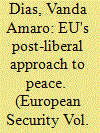

|
|
|
|
|
| Publication |
2013.
|
| Summary/Abstract |
This article analyses what may be termed as the European Union's (EU) post-liberal approach to the Moldova-Transnistria conflict. Since 2003, within the ENP framework, the EU has become increasingly committed to its transformation. Such an engagement is further confirmed by the establishment of the European Union Border Assistance Mission to Moldova and Ukraine (EUBAM) in 2005, aimed at building confidence between the parties, stimulate their economic interdependence and change perceptions about the conflict. The mission's outcomes are moving beyond its technical scope, supporting the conflict peaceful transformation. The focus on bottom-up initiatives and local engagement allows for a broader understanding of the complex dynamics underlying the conflict, which together with the high-level negotiation process may provide a holistic approach to its resolution and increase the likelihood to reach a sustainable settlement.
|
|
|
|
|
|
|
|
|
|
|
|
|
|
|
|
| 2 |
ID:
144778
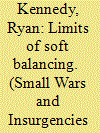

|
|
|
|
|
| Summary/Abstract |
Both the EU and NATO have greatly expanded efforts to address the frozen conflict in Transnistria since 2003. These efforts by and large fall neatly into the category of ‘soft balancing’ actions against Russian influence in the conflict and in Moldova more generally. Given that soft balancing is normally seen as a strategy undertaken by relatively weak actors vis-à-vis a global or regional hegemon, this behavior is puzzling. The actions of these institutions demonstrate that soft balancing is a logical strategy for stronger actors when the conflict is not as salient as for the weaker actor. The EU and NATO’s desire to resolve the conflict is not salient enough to warrant a costlier hard power strategy. Recent developments in Ukraine also demonstrate the limitations of this strategy. Specifically, the application of this soft power has done little to change the incentives for separatist leaders or their Russian backers, meaning they have little ability to resolve the conflict. They have also fallen short of creating a permanent pro-Western consensus in Moldova. They do, however, augment Moldova’s ability to adapt to the challenges posed by the conflict and provide a paper wall against more aggressive Russian ambitions in the region.
|
|
|
|
|
|
|
|
|
|
|
|
|
|
|
|
| 3 |
ID:
165637
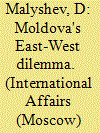

|
|
|
|
|
| Summary/Abstract |
IN RECENT YEARS, the territory of the former Soviet Union has been the site of escalating East-West rivalry. On one side there are Euro-Atlantic bodies - the European Union and NATO. On the other there are the Collective Security Treaty Organization (CSTO) and the Eurasian Economic Union (EAEU), organizations active on former Soviet territory. This rivalry was made more intense by the crisis of 2013 and 2014 in Ukraine and the reunification of Crimea with Russia. The future nature of international relations in ex-Soviet territory and those in Europe as a whole largely depends on whether former Soviet republics will prioritize relations with the EU or activities in the EAEU format. For Moldova, this is a vital choice to make for historical (and geographical) reasons.
|
|
|
|
|
|
|
|
|
|
|
|
|
|
|
|
| 4 |
ID:
075248
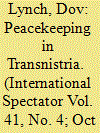

|
|
|
|
|
| Publication |
2006.
|
| Summary/Abstract |
Turning to Moldova, Dov Lynch analyses how and why the conflict in Transnistria remains unresolved. The "frozen" nature of the peace process in the Moldova-Transnistria conflict is due to a set of local, national, regional and international factors. These include the separatist platform of the Transnistrian leadership on the one hand and the weakness of the Moldovan state on the other. Regional and international factors fuelling the stalemate include Russian interests, Ukrainian ambiguity, and the international community's relative neglect, all of which have contributed to a distorted and cumbersome process of international peacekeeping and mediation. Yet Lynch discusses how several of these factors are undergoing a process of deep-rooted evolution. Hence, while the peace process remains frozen, the conflict itself is not. The foreign policy shift of the Moldovan government since 2003, the hardening stance of the Transnistrian authorities, the increased assertiveness of Russia, the growing involvement of the enlarged EU and the regime change in Ukraine have all altered the state of play in the conflict. The ensuing unfreezing of the status quo presents both risks and opportunities. In order to capitalise on the latter, Lynch sets forth several guidelines for EU policy in the region.
|
|
|
|
|
|
|
|
|
|
|
|
|
|
|
|
| 5 |
ID:
107042
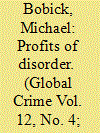

|
|
|
|
|
| Publication |
2011.
|
| Summary/Abstract |
This article looks at the multiple constructions that constitute the image of the Transnistrian Moldovan Republic (PMR), a separatist region located in eastern Moldova. The European Union (EU) and the international community construct the area as a 'black hole', a security and terrorist concern. The PMR has constructed the state's image on the basis of the memory of collective suffering at the hands of Moldovan oppression, in a fashion that resembles state building in nineteenth-century Europe. The best-selling author Nicolai Lilin invests a criminal Ruritania in his fake memoir of criminal tales and exploits. The article shows that a degree of order and legitimate means to make money exist in the PMR while it highlights a key and largely ignored element of the political economy of the PMR, namely the economic role and monopolistic practices of Sheriff and the strong interconnection between politics and economic activities.
|
|
|
|
|
|
|
|
|
|
|
|
|
|
|
|
| 6 |
ID:
147780
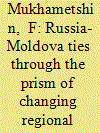

|
|
|
|
|
| Summary/Abstract |
RUSSIA AND MOLDOVA have for centuries been connected by close bonds of friendship, as amply evidenced by the history of both countries. In the 15th century, Stephen III (Stephen the Great) of Moldavia wrote to Ivan III: "Only God has taught your grace to turn toward us and show us your friendship, and I would be even friendlier toward your grace." The Moldavian ruler saw the Moscow prince not only as a promising partner in international affairs but also as a spiritually close friend and kinsman (Stephen married his daughter off to Ivan Ill's son). No doubt, the common Orthodox faith and common values have been, and still are, an important unifying factor for both countries. However, the historical assets of friendship and cooperation between the Russian and Moldovan peoples are not limited to that.
|
|
|
|
|
|
|
|
|
|
|
|
|
|
|
|
| 7 |
ID:
179204


|
|
|
|
|
| Summary/Abstract |
Do authoritarian regimes engage in active export of their political systems? Or are they primarily concerned about their geopolitical interests? This article explores these questions by examining Russia’s policy towards Abkhazia, South Ossetia, and Transnistria. In all three de facto states, Moscow is fully able to dictate election outcomes should it desire to, but, we argue, has increasingly refrained from doing so. These client states are unlikely to attempt to escape from Russia’s tutelage; and with its geopolitical interests fully ensured, Russia appears willing to grant them latitude. We then ask whether these findings can be extrapolated to serve as a template for understanding Russia’s policy towards its client states more generally, discussing Moscow’s reactions to attempted regime change in Armenia and Belarus.
|
|
|
|
|
|
|
|
|
|
|
|
|
|
|
|
| 8 |
ID:
144775


|
|
|
|
|
| Summary/Abstract |
This article focuses on how unrecognised states have tried to establish themselves domestically and internationally, and on the efforts of base states designed to counter these initiatives. Having provided an overview of the main features of post-Soviet unrecognised states, we examine the political systems found in these territories, focusing on their presidents, parliaments, and elections. We then focus on how unrecognised states strive to strengthen themselves through support from abroad, in spite of international isolation. Finally, we debate the strategies enacted by base states to counter such efforts and deny international legitimacy and recognition to these entities.
|
|
|
|
|
|
|
|
|
|
|
|
|
|
|
|
| 9 |
ID:
156341


|
|
|
|
|
| Summary/Abstract |
IN JUNE 2017, it was 25 years since the tragedy in Bendery, a Moldovan city whose population had rejected the plans of Chisinau nationalists to prohibit them from using Russian at work and in everyday life and from teaching Russian to their children. Attempts to reach a compromise on the "right to use one's own language" had failed. Moldova split apart and the conflict turned into an armed confrontation. On March 2, 1992, Moldovan troops, using armored vehicles and artillery fire and supported by Romanian volunteers, launched a full-scale military operation against Transnistria (Pridnestrovie). On June 19, 1992, almost 700 civilians lost their lives as a result of a massive artillery strike on the city of Bendery; more than 1300 people were wounded, and 100 thousand became refugees. The city was saved from destruction by the arrival of the Russian 14th Army. At a meeting in Moscow on July 21, 1992, the presidents of Russia and the Republic of Moldova, in the presence of the president of the Pridnestrovian Moldavian Republic (PMR), signed an Agreement on the Principles of a Peaceful Settlement of the Armed Conflict in the Pridnestrovian Region of the Republic of Moldova.
|
|
|
|
|
|
|
|
|
|
|
|
|
|
|
|
| 10 |
ID:
177537
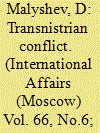

|
|
|
|
|
| Summary/Abstract |
THE CONFLICT between Moldova and Transnistria is nearly 30 years old. It erupted when the Soviet Union was falling apart, and there is no chance of it being resolved any time soon. No plans for its settlement have worked. It is not a unique frozen conflict in the post-Soviet space. There are others similar in nature. The conflict between Armenia and Azerbaijan over Nagorno-Karabakh and Georgia's conflicts with South Ossetia and Abkhazia broke out practically simultaneously with the Transnistrian conflict and have equally unresolvable problems at their basis. This category of frozen confrontations also includes a comparatively new conflict in southeastern Ukraine, which was provoked in 2014 by a coup in Kiev involving the ouster of President Viktor Yanukovich - the population of the regions of Donetsk and Lugansk refused to recognize the self-established regime in Kiev as a legitimate government and put up armed resistance to it.
|
|
|
|
|
|
|
|
|
|
|
|
|
|
|
|
| 11 |
ID:
163794


|
|
|
|
|
| Summary/Abstract |
Shock events are often pivotal moments in geopolitics and objects of intense disagreement among conflicting parties. This paper examines the downing of a Malaysia Airlines passenger jet over eastern Ukraine in July 2014 and the divergent blame storylines produced on Russian and Ukrainian television about the event. It then examines results of a question asking why MH17 crashed in a simultaneous survey conducted in December 2014 in six oblasts in Southeastern Ukraine, Crimea, and the de facto states of Abkhazia, South Ossetia and Transnistria. An analysis of the surveys shows that blame attribution was driven more by television viewing habits than by any other factor.
|
|
|
|
|
|
|
|
|
|
|
|
|
|
|
|
|
|
|
|
|